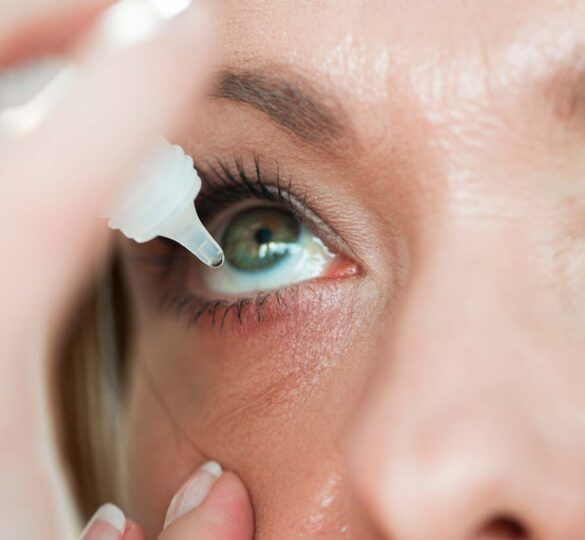Preservative-Free Eye Drops for Glaucoma

Glaucoma medications that are free of preservatives may significantly reduce symptoms of ocular surface disease for some patients.
Glaucoma is a chronic disease that causes irreversible vision loss, requiring long-term care and treatment.
Eyedrop medications are often used to treat glaucoma and approximately 50% of patients use more than one glaucoma drop.
Prolonged use of these medications can cause significant ocular surface disease (OSD), including dry eye syndrome in some patients.
The inactive ingredients in the eyedrops (specifically, the preservative), as well as the active ingredient (that lowers eye pressure) have both been associated with OSD.
While most patients tolerate one or two eyedrop medications well, the side effects of preservatives can be additive, especially when patients are using more than two different glaucoma drops.
Why are preservatives added to glaucoma drops?
The addition of preservatives prevents bacterial contamination and is a requirement by regulatory authorities when manufacturing the medication.
What is the main preservative found in glaucoma drops?
The most frequently used preservative is Benzalkonium Chloride (BAK). It is very effective against several microorganisms but is also known to cause increased inflammation of the ocular surface and cell disruption.
Are there other, better tolerated, preservatives?
Yes, preservatives that are better tolerated by some patients include Purite and SofZia and they are found in certain formulations of Brimonidine and Travoprost. These preservatives may be less disruptive to the eye surface than BAK because they get inactivated quickly upon contact with the eye. Both options have been shown to be better tolerated by some patients, causing less eye redness and symptoms of dry eye disease.
Purite is the preservative found in branded Alphagan P 0.1% or 0.15%, as well as in generic Brimonidine Tartrate 0.1% or 0.15% manufactured by Pacific Pharma. SofZia is used in Travatan Z 0.004% and certain, generic versions of Travoprost 0.004%.
What preservative-free options are available to glaucoma patients?
Preservative-free glaucoma eye drops include: Timoptic 0.5% Ocudose (preservative-free Timolol), Dorzolamide 2%-Timolol 0.5% PF (preservative-free Cosopt), Iyuzeh (preservative-free Latanoprost), and Zioptan (Tafluprost 0.0015%).
Due to the absence of antimicrobial activity in these eye drops, they are packaged as a sterile solution in a single-use container. Once opened, the medication is instilled into the eye, and patients then promptly toss the container with its residual contents. In addition to these commercially available eyedrops, some preservative-free medications are available via specialized compounding pharmacies.
What is the insurance coverage like for preservative-free options?
Unfortunately, preservative-free glaucoma medications are not well-covered by many health insurance plans. You may have to first try medications that contain preservatives before your insurance plan approves coverage for preservative-free medications. Your doctor can help you by submitting a prior authorization request or an appeal to the insurance provider.
The good news is that more preservative-free and BAK-free medications are available as generic formulations now compared to even a few years ago. In the United States, these generic medications include preservative-free formulations of timolol, dorzolamide-timolol, and tafluprost; generic brimonidine tartrate 0.1% or 0.15% from Pacific Pharma (has Purite); and travoprost from Sandoz (has SofZia).
How else can I minimize the side effects from preservatives?
SLT laser treatment can help reduce the need for medications in many types of glaucoma. In addition, the side effects of preservatives can be minimized with approaches such as using combination medications and long-acting eyedrops that are used once a day.
Sustained release implants that are injected or implanted into the eye have been approved for single administration and the best way to use them is still being explored. Your doctor can help you with a treatment plan that enables good eye pressure control while minimizing side effects.
Nanodropper, a portable eye dropper attachment, can potentially reduce side effects from medications and preservatives by significantly reducing the volume of each drop. It attaches to most standard eye drop bottles and dispenses smaller drops, maximizing the number of doses per bottle.
Article by Arpine Barsegian, MD. Posted on January 3, 2025.

Arpine Barsegian, MD
Dr. Arpine Barsegian is a board-certified, cornea and glaucoma fellowship trained ophthalmologist. She is a glaucoma specialist and cataract surgeon at Astorino & Associates Eye Center in Orange County, CA. She is an active member of the American Glaucoma Society and the American Academy of Ophthalmology.